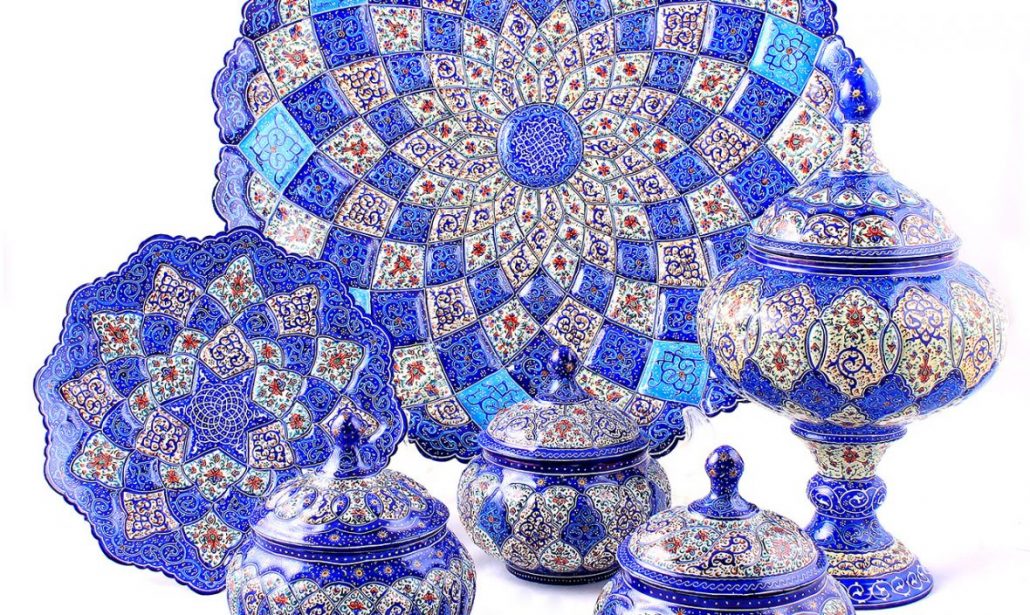Iran, as one of the most ancient civilizations of the world, and the land of many tribes so different in culture, lifestyle, and tradition has enjoyed a wide variety of handicrafts during history. Persian handicrafts, each narrating the stories of the culturally diverse populations in different parts of vast Iran, are among the best souvenirs for the tours to Iran.

Baluchi Suzandozi
Iranian weavings are well-known for their antiquity, elegance, durability and variety. The most famous one is the Persian carpet. It has been used as the covering for floors for thousands of years in Great Persia. Different geometrical shapes, medallions, tendrils, and figures of plants and animals woven with local materials specific to each area, inspired by the natural environment, remind people of colourful Persian gardens; full of flowers and birds. Persian rugs woven by nomads are different in style and design. The most prominent nomad rugs include Gabbeh, Kilim and Jajim. Iranian fabric named Ghalamkar is made by hand drawing or printed by the use of patterned wooden stamps. Termeh is another Iranian hand-woven cloth, primarily produced in Yazd. Its weaving is very delicate and time taking. The most famous of the factories producing traditionally woven Termeh is called Rezaei Termeh. Another kind of Persian weaving embroidery is Zardozi. It is making designs using gold and silver threads, pearls and precious stones. Nowadays, copper wires polished by gold or silver, and silk threads are used as well. It also includes Goldozi (embroidery stitches), Baluchi Suzandoi (needlework), Seke dozi (shisha embroidery), Rashti Qollabdozi (special kind of broderie), and Kermani Pateh duzi (a style of Iranian embroidery).

Persian Wood Work
Persian art of handicrafts goes beyond textile weaving. It includes metal works, wood works, pottery, miniature, calligraphy, straw made products, mosaic and stone. The beginning of Persian metalwork goes back to Luristan bronzes. Iranian Metal works include Minakari (Enamel working) and Ghalamzani (also Qalamzani or Toreutics) wherein a metal is decorated with colourful coats, and carved or hammered. Isfahan is well-known for its enamel artworks.
Wood works in Iran comprises Moarragh or Moarraq (an Iranian handicraft made of small pieces of different woods) and wood carving. Khatamkari is another Persian art of marquetry dating back to Safavid period. The artist decorates the wooden surface of the jewellery boxes, chessboards, desks and suchlike with different shapes (generally star-shaped) of pieces of wood, bone, metal, and sometimes gold, silver, ivory, and brass. Sometimes it is combined with miniature to make a unique work of art.
Persian art is not limited to abovementioned and goes to the stone and mosaic. Turquoise Inlaying on jewellery or materials such as silver, copper or brass is one of the distinct Iranian handicrafts. The turquoises of Mashad and Nishapur have the most fame with the highest quality. Pottery and ceramics have a long history in Iran. Pottery dates back to more than around 6-7 thousand years ago in Susa, Tepe Sialk in Kashan, Jiroft, and the Burnt City. Kalpuregan Museum in Sistan and Baluchestan province is called the only live ceramic museum; because its working style has passed from generation to generation over 5 thousand year without any change.

The Art of Minakari
Persian tilework is one of the spectacular Iranian art crafts. In the past, Isfahan and Tabriz were two main centres of Iranian mosaic. Golestan Palace in Tehran is another outstanding example of Persian tilework for the tours to Iran.
Miniature rose up in Iran in the 13th century and continues to this day. It is a very detailed usually small painting that requires great skill and proficiency, and an extremely small brush to paint such intricate elaborate artwork. The best example of the modern Persian miniature is Frshchian’s. Persian calligraphy has several styles. Calligraphic embellishments have had the main role in Iranian pottery, metalwork, and historical buildings. Calligraphy reached its peak in illuminations of Quran, Shahnameh, Divan-e Hafez, and other well-known Iranian literature. Nastaliq is the most popular Persian calligraphy style, known as “Bride of the calligraphy scripts”.
Source: click here